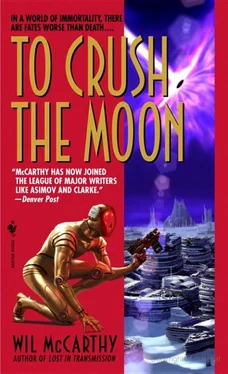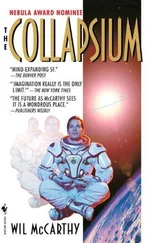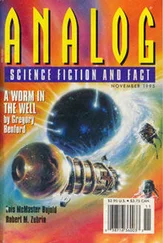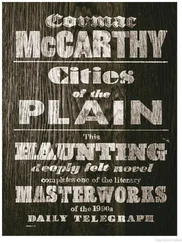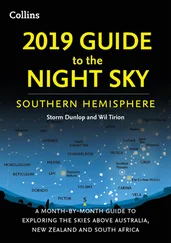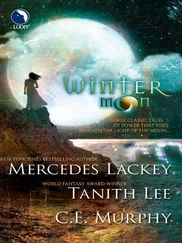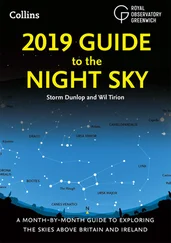By now, the wellstone’s awareness was no longer limited to a handful of lightly powered hull plates. Indeed, almost the entire structure had come alive, and was slowly charging itself, rearranging its electronic structure, becoming a proper starship hull and skeleton once again. And in its newfound powers the starship remembered its manners, and produced a soft yellow glow from the cabin’s frosted ceiling.
“Ah. Thank you,” Bruno said, though it wasn’t clear whether the ship could actually hear or understand him yet.
Bouncing lightly along the hoarfrost-crackling floor, he moved to the cabin’s only exit. He smiled, for here was an actual door , not some temporary aperture but an actual plate hung on mechanical hinges and enclosed within an actual door frame. There was even a little knob or handle which, if he recalled correctly, one had to turn in order to release the latching mechanism. He grasped the handle, turned it, and with delight felt something click and release between the door and its frame. He pushed, and felt a sort of crunching through the wellcloth of his armor as the frost-sealed door broke free and swung open. Marvelous!
Bruno himself had grown up in Old Girona, before the Queendom, at the very peak of the Catalan love affair with ancient habits and technologies and social mores. The Sabadell-Andorra earthquake had of course smashed that daydream—and Bruno’s own parents, and thousands of other human beings besides. It was the last great disaster of Old Modernity. But before then he had turned his share of doorknobs, uncorked his share of glass bottles, even knotted his shoes to his feet with laces of hand-woven cotton! He was careful not to overromanticize those days, but he wasn’t above the occasional reminiscence.
Outside the cabin was a circular hallway, linking six similar cabins around the ship’s circumference, and in the center of the floor was a steep ladder leading both up and down. Bruno had been on this ship once before, touring it with Tamra after its christening, but that was a thousand years ago, and bore no resemblance to the scene before him now. Nevertheless, from his scans he knew that the four corpses of interest, and the laboratory which held them, were two levels aft from this point. So he mounted the stairs, wrapping a hand around each rail, and glided down.
This proved a mistake, however, for the “gravity” at the bottom of the first flight of stairs was more than three times what it was at the top—very nearly a full gee! He staggered under sudden weight, collapsing to his armored knees at the bottom. The sensation of spinning was also more pronounced here. Picking his way around the staircase, he took the next flight more cautiously.
Two centimeters of wellcloth space armor massed twenty kilograms all by itself, with the solid helmet adding another two or three, but fortunately a properly designed suit would stiffen and relax in response to its wearer’s movements, lightening the burden. Carrying its own weight, as it were, and in heavy gravity it would do its best to carry your weight as well. God bless the stuff.
This level had the same circular corridor as the one above, but with only two hatches instead of six. Bruno chose one, and on the other side he found a ring-shaped chamber far less tidy than the rest of the level. Its floor was littered with hand tools, with dead wellstone hoses and sketchplates, with other items he couldn’t immediately identify. The air had frozen over these tumbled implements, and afterward nothing had moved. For centuries.
There were six support columns holding the floor and ceiling apart, and by these landmarks he circumnavigated the chamber, noting the position of the four corpses in their coffins of glass. And then, approaching one, he felt a dizzy wash of déjà vu.
“I know this man,” he muttered, and felt in his bones that he had said this before, on another spaceship somewhere, contemplating some other frozen corpse. During the chaos of the Fall? Life was long, and like any bounded system with finite variables it must repeat itself periodically. No matter how improbable the event.
Unless Bruno was badly mistaken, this crystallized starman had been a privateer during the Children’s Revolt. A revolutionary, a confidant of Prince Bascal, and later a builder of orbital towers on the face of Planet Two, better known as Sorrow.
“He is Senior Commander Conrad Ethel Mursk,” said a quiet voice in Bruno’s helmet. “First Mate of the QSS Newhope and First Architect of the Kingdom of Barnard.”
“Ah, so you’re awake,” Bruno said to the walls and bulkheads around him.
“Aye, Sire,” replied the QSS Newhope in some radio frequency or other, and in vaguely feminine tones. By tradition, machines had an accent of their own which set them apart from human beings, but the Barnardean mechsprach was slower and breathier than the Queendom’s own—almost comically so. “You honor us with your presence.”
“Us? Are these people alive, then?”
“These four were,” the ship said, “when I froze them after the accident. They were my crew.”
“Ah.” Curious, that. A crew of four for an entire starship?
“However,” the ship continued, “since reviving them is beyond my capabilities, the answer to your question rests upon your definition of the word ‘alive.’ There are bodies in my cargo pods as well, who died and were frozen before the journey began. So I will answer, guardedly, that four of these people are alive, and twenty-five thousand are dead but presumed recoverable.”
“I see. Thank you.” Bruno was about to ask for further clarification when he felt a hand on his shoulder.
“Gaah!” he cried, spinning in surprise and alarm. One did not expect to be touched onboard a ghost ship! But as he wheeled around, dizzy against the ship’s own spinning, what he saw behind him was no ghost or zombie but his own wife, Queen Tamra-Tamatra Lutui, in her own suit of space armor—royal purple trimmed with gold. She didn’t look happy, and flanking her on either side were an equally unamused-looking admiral and a burly midshipman, both in navy black. And behind them were a pair of superreflective Palace Guard robots—a reminder that Bruno himself was here, against laws and traditions and the insistence of his staff, without his own two guards. It had taken a Royal Override to dismiss them, but Tamra’s override trumped all others. Were these two for him?
Blast.
“Hello, dear,” he tried saying.
She crossed her arms, nodding once inside her helmet. “Darling. Malo e leilei . It was very kind of you to bring an active fax portal and network gate here. It saves us all kinds of time. Why, we can fax here directly from Malu’i , still en route.”
“Ah. Well, er, you’re welcome.”
“Were you planning on telling me any of this?”
“I told the house staff,” he said. “And Traffic Control.” But that sounded weak and plaintive in his ears. She might be the Queen of Sol, but he was the king, and her husband, and a grown man who had invented this sort of mad ertial errand during a time when all of humanity hung in the balance. “If you’re here to help, why don’t you send these navy lads down for about fifty barrels of deutrelium and some labor robots? On my personal account, if budgets are a concern. I’d like to fire up the reactors and halt this damned spin.”
Tamra favored her husband with a glare, then turned to the admiral. “Do as he says, please. And bring qualified assistants who can help him bring this vessel under control.”
Chapter Three
in which the consequences of immorbidity are lamented
A trip through the fax was the treatment of first resort for any ailment or injury, but the Nescog morbidity filters were meant to repair the living. Clever algorithms examined the genome, along with its appendices and parity blocks, in a large enough sample of cells to screen out any accumulated mutations. Then, based on this corrected blueprint the system extrapolated what the body ought to look like—allowing of course for undocumented cosmetics—and then compared that ideal with the scanned body image itself, rearranging the cell structure as appropriate. All damage and signs of aging were wiped away in the process, rendering the subject “immorbid.”
Читать дальше
